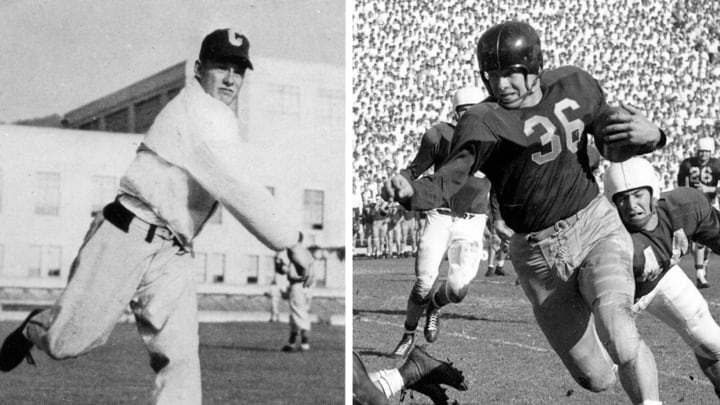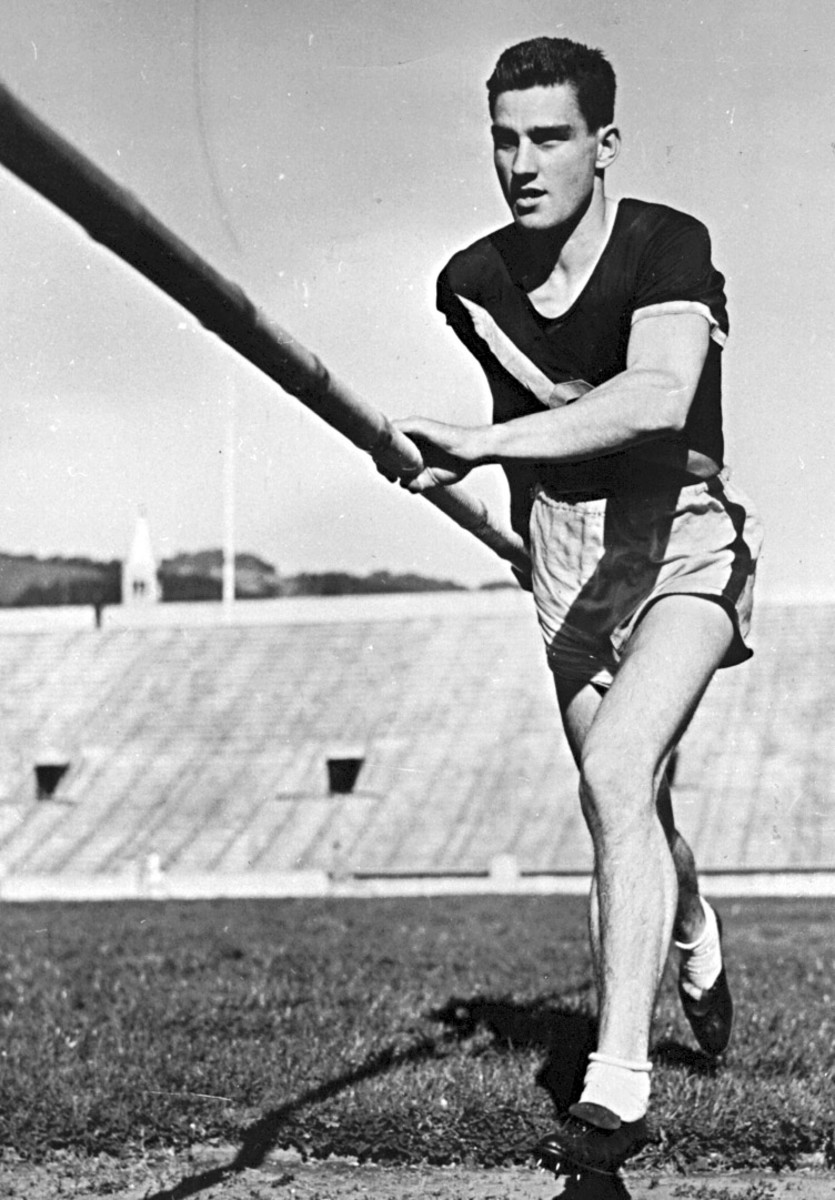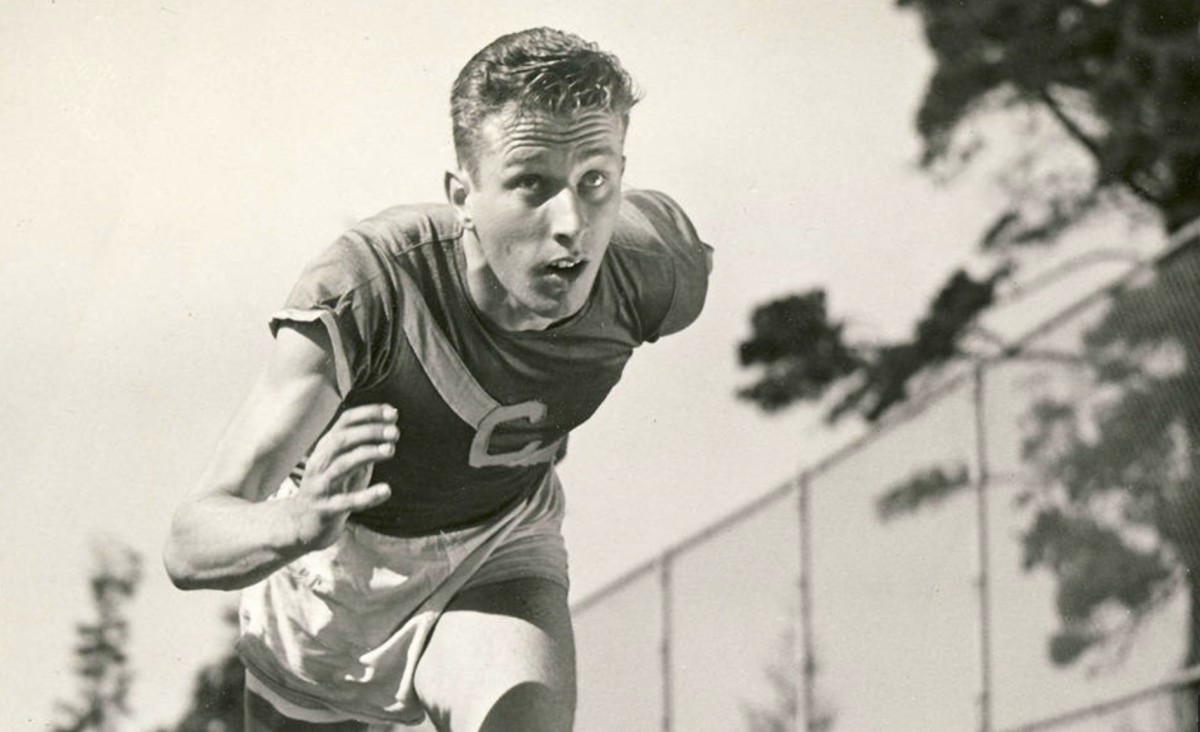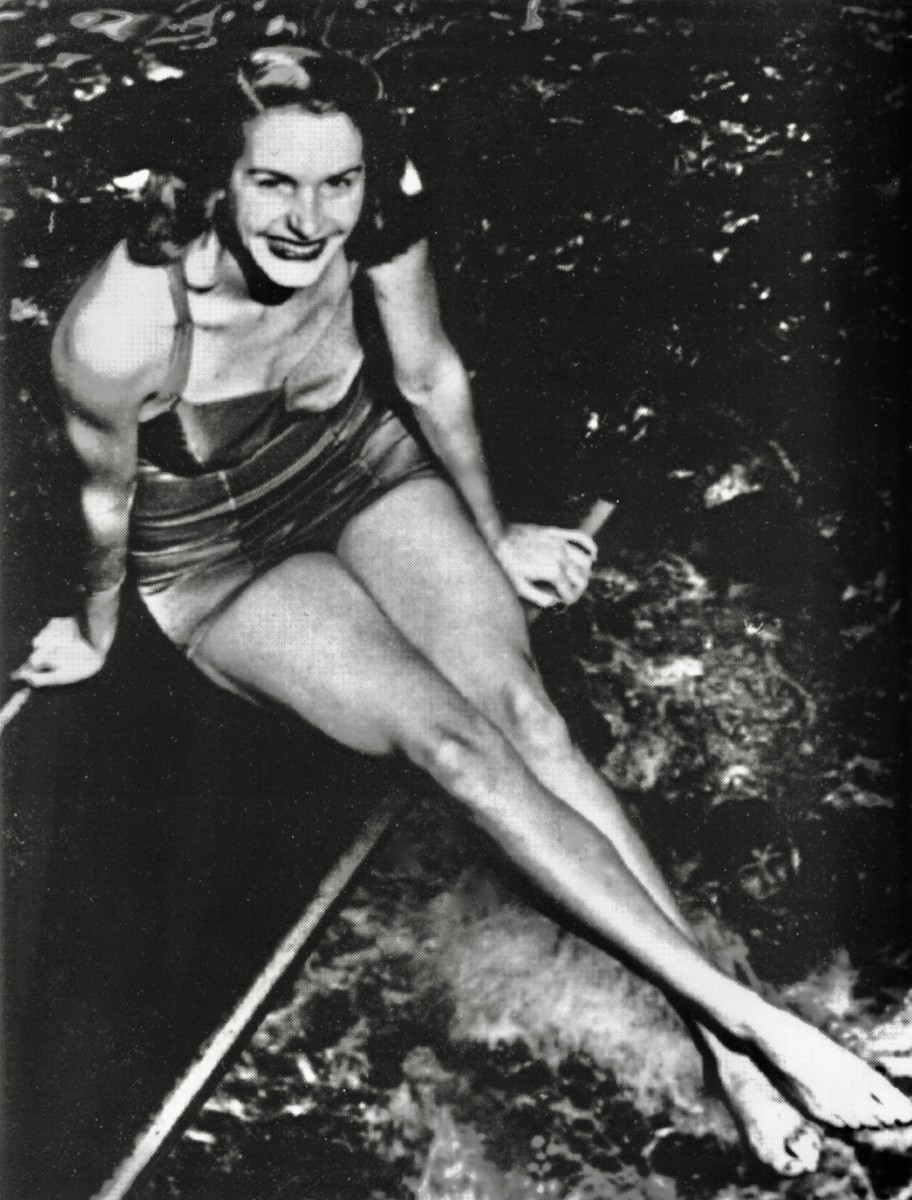The Best of the Bears, Part 4: Cal's Top Athletes of the 1940s

The 1940s were a grim time thanks to World War II.
Cal, which became a sports powerhouse in the post-war years, struggled through significant portions of the decade.
Pappy Waldorf arrived in 1947 and immediately sparked a football surge, going 38-4 over his first four seasons with three trips to the Rose Bowl. But the Bears were 18 games under .500 the first seven years of the decade.
Nibs Price coached the basketball team to a still-standing school record of 30 victories and a trip to the Final Four (before it was called that) in 1945-46, the first academic year after the war ended. That triggered a three-year run in which the Bears were 75-26. They were 15 games under .500 the rest of the decade.
Track and field produced Cal’s most accomplished athletes during the pre-war years of the 1940s and the decade ended with the emergence of the “Golden Boy,” two-sport star Jackie Jensen.
*** Jake Curtis discusses his choice as most intriguing Cal athlete of the 1940s:
Here are our picks for Cal’s Athletes of the Year in the 1940s:
1939-40: MARTY BILES (track & field). Biles won the 1940 NCAA javelin throw with a mark of 204 feet, 10 inches, then repeated as champ in ’41, throwing 220-1. Biles set a school record of 227-11 that season. He won AAU national titles in 1943 and ’44 and competed at the 1948 Olympics in London. He had the top throw in the qualifying round, a toss of 222-0 that would have secured him the silver medal had be been able to duplicate it in the finals. Instead, he finished sixth at 213-9. Two years after Marty won his second NCAA crown, younger brother Robert Biles claimed the 1942 title. Robert Biles died during a World War II bombing mission over Austria in 1945.

1940-41: GUINN SMITH (track & field). Smith scaled 14 feet, 2 inches to tie for the pole vault championship at the 1941 NCAA meet. He then served in the military during World War II, flying cargo planes over the Himalayas to deliver supplies to the Allies. After the war, Smith returned to the sport and overcame a war-time plane crash knee injury to become an upset winner of the gold medal in the pole vault at the 1948 Olympics, beating future two-time gold medalist Bob Richards. In a London downpour, Smith cleared the winning height of 14-1 1/4 on his final attempt to give the U.S. its eighth straight Olympic title in the event. Richards, who became the Wheaties box cover boy, later said admiringly of Smith, “He was the epitome of the Western cowboy. You could see those hard eyes. I think the reason we won the war was because of guys like Guinn Smith.”
1941-42: HAL DAVIS (track & field). Davis won the sprint double at the NCAA championships, capturing the 100-yard dash in 9.6 seconds and the 220 in 21.2, helping the Bears to a third-place finish in the team competition. A year later, the “California Comet” won both events again and Cal finished second. Davis tied Jesse Owens’ world record of 10.2 seconds in the 100 meters in 1941 and went four years without losing a race in the 220-yard or 200-meter sprint, but World War II canceled both the 1940 and ’44 Olympics, depriving him the sport’s biggest stage.

1942-43: GROVER KLEMMER (football/track & field). World War II reduced the number of men attending college, and Cal’s sports teams felt the impact. The Bears never had a winning football season during wartime, but Klemmer — the world-record-holder in the 400 meters and 440-yard dash and a two-time USA champion in the one-lap event — made a one-year appearance in football and helped the ’42 squad get to 5-5. In a season-ending win over Navy Preflight, a military team featuring Bay Area college stars Vic Bottari, Bobby Grayson and Frankie Albert, Klemmer threw the decisive 17-yard touchdown pass to Billy Reinhard in 12-6 victory. During World War II, he played football for future Hall of Fame coach Paul Brown at the Great Lakes Naval Academy in Chicago. Klemmer later coached football at City College of San Francisco (where he helped develop Ollie Matson and Burl Toler) and enjoyed a two-decade career as an NFL game official.
1943-44: NO ONE (in any sport). WWII gets a huge share of the blame for this because so many young men were in Europe or the Pacific, but the 1943-44 school year was perhaps Cal’s worst on the playing field. The football team was 4-6 and was shut out four times. The basketball team was 7-3 but played fewer games than any season since 1918-19. The baseball team was 9-14, its only losing campaign over 36 season from 1927 until 1963. Track and field sent no one to the NCAA meet. No all-conference selections, no national champions. Pretty much no nothin’.
1944-45: KENNETH GUSTAFSON (baseball). In another season shortened by World War II, Gustafson batted .428 to help the Bears win the Pacific Coast Conference title with a 7-1 record, their third championship in five seasons. Cal was 12-9 overall. Gustafson later played on the Bears’ 1947 College World Series title team.
1945-46: MERV LaFAILLE (basketball). LaFaille, a 6-foot guard from Oakland, played for the Bears in 1940-41 and ’41-42 then was otherwise occupied during World War II. He returned to the squad four years later and was the captain and No. 2 scorer (8.3 points) on a team that went 30-6, won the Pacific Coast Conference at 11-1 and advanced to the Final Four.
1946-47: JOHN FISCALINI (baseball). After serving in the Air Force during World War II, Fiscalini enrolled at Cal and as a junior in 1947 led the Bears to the first College World Series title. The left fielder led the Bears in hitting with a .414 batting average and earned first-team All-America honors. He signed with the Pittsburgh Pirates in 1948 and played three seasons in the minor leagues before retiring.

1947-48: ANN CURTIS CUNEO (swimming). Cal did not have a women’s swimming program during Curtis Cuneo’s time at Cal (1944-1948), but she became world famous nonetheless. After establishing world freestyle records at 100 yards, 400 meters and 440 yards in 1947, she won two gold medals and a silver medal in the 1948 Olympics just a few weeks after graduating from Cal. In those London Olympics, she won the 400-meter freestyle, swam a leg on the United States’ winning 4 x 100-meter freestyle relay team, and placed second in the 100 freestyle. At the time, there were only five Olympic swimming events for women, and athletes were allowed to enter only three events. Curtis Cuneo’s Olympic success was not a surprise, as she was featured on the cover of Newsweek a few days before the London Olympics began. She was the only American woman to win an individual gold medal in any event at the 1948 Olympics, and she was inducted into the International Swimming Hall of Fame in 1966. Also: Andy Wolfe (basketball), Chuck Hanger (basketball/track & field).
1948-49: JACKIE JENSEN (football/baseball). After serving in the Navy at the end of WWII, the Oakland High School graduate enrolled at Cal and became one of the school’s greatest all-around athletes. In 1947, as a junior pitcher and outfielder, Jensen earned baseball All-America honors, batting .385, as the Bears won the inaugural College World Series crown. As a senior running back in 1948, Jensen rushed for 1,080 yards on 7.3 yards per attempt and scored seven touchdowns to pick up consensus first-team All-America plaudits as Cal posted a 10-0 regular-season record and a final No. 4 national ranking before losing to Northwestern in the Rose Bowl. Jensen finished fourth in the Heisman Trophy voting that season (SMU’s Doak Walker won the award, despite rushing for 482 fewer yards). In the 1949 baseball season, Jensen set a school record for home runs that lasted 25 years. In October 1949, Jensen married high school sweetheart Zoe Ann Olsen, a silver medalist in diving at the 1948 Olympics, in what was a huge Bay Area social event. Jensen went on to a major league baseball career highlighted by an American League MVP award in 1958, when he hit 35 home runs and collected a league-leading 122 RBIs. But a fear of flying and anxiety over missing his family led Jensen to retire for one season after 1959, then permanently two years later. Jensen, who later coached Cal’s baseball team for four seasons, was inducted into the National Football Foundation Hall of Fame in 1984.
Click here for Part 2 of the series: Top Cal athletes of the 1920s
Click here for Part 3 of the series: Top Cal athletes of the 1930s
Follow Jeff Faraudo of Cal Sports Report on Twitter: @JeffFaraudo
Click the "follow" button in the top right corner to join the conversation on Cal Sports Report on SI. Access and comment on featured stories and start your own conversations and post external links on our community page.
